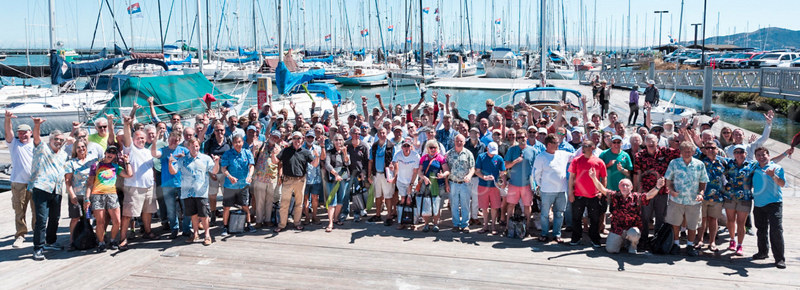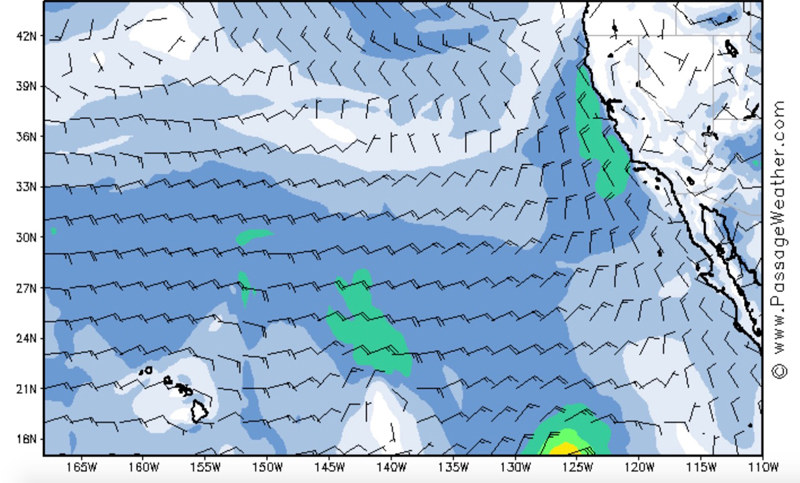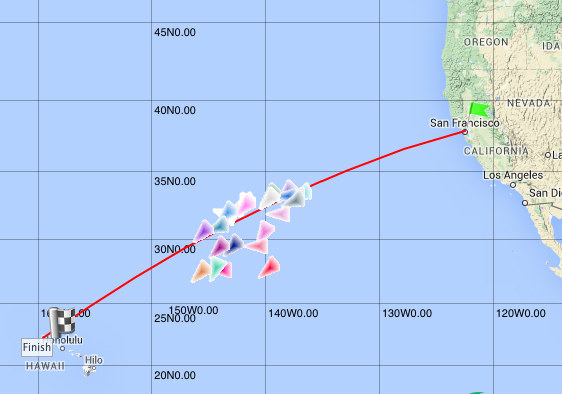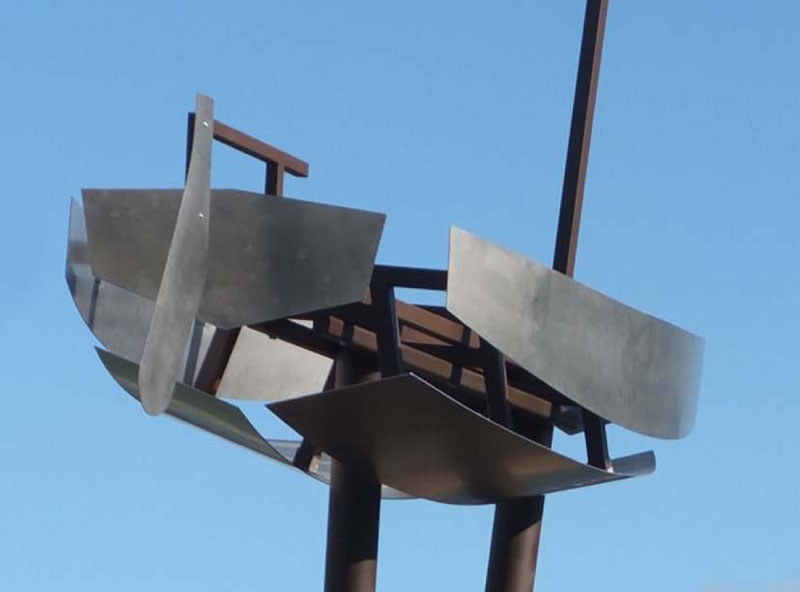
Let the 2016 Pacific Cup Begin!

By the time that you read this, the first three divisions of this year’s Pacific Cup fleet — including the Latitude 38 cruiser’s division — should be out the Gate and headed to the promised land of Kaneohe Bay, Oahu. With light to moderate breeze predicted on the Bay this morning, the end of an ebb to flush the fleet out to sea, and strong coastal northwesterlies, conditions look right to get these first fleets off to a quick start.
With the first gunshot firing off the St. Francis Yacht Club’s race deck at approximately 10:10 a.m. this morning, Division A "Honu" charges the starting line to officially get the 2016 Pacific Cup under way. Among the starters is a unique mix of mostly classic racer/cruisers, including a pair of match races between familiar West Coast classics. Kit Wiegman’s Alameda-based Islander 36 Cassiopeia faces off against Eric Mueller’s San Francisco-based sistership Serenity (though Serenity rates ever so slightly faster). The second match race of the Honu division stars Steve Calhoun’s Los Angeles-based Cal 40 Psyche and Walter Smith’s Richmond-based Cal 40 Redhead. Honu is rounded out by Mel Morrision’s Orion 35 Nicole, Lad Burgin’s 40′ Allied Mistress ketch Shadowside and Kerry Sheehan’s X-Yacht 362 Windswept Lady.

At Latitude 38, one thing we’re passionate about is relating the oftentimes epic stories of the small Santa Cruz ULDBs that take on a big patch of blue water and race to Hawaii. With another classic match race and an interesting mix of small ULDBs, classic plastic and displacement racer/cruisers, the Kolea Doublehanded division is as diverse as they come, and only brought together by small crew sizes. Mark English and Ian Rogers have certainly put in the time and effort to do well in this race, logging some impressive victories along the way, and look to be a factor in their Moore 24 SC Mas! To win, they’ll be racing nearly heads-up against the Portland-based Moore 24 Evermoore, which rates just slightly slower than Mas! Also repping the PNW will be the race’s sole Express 27 entry Alternate Reality, sailed by brothers Darrel and Jay Jensen. The fleet’s scratch boat is an interesting entry in the quick and sexy Archambault 27 Alchimiste, while a trio of larger heavier-displacement boats, including the Cal 40 Nozomi, round out the division.
The largest fleet to start on Monday is the Latitude 38 cruisers’ division, which includes 11 boats ranging in size from the Nelson Marek 36 Alegria to the Jeanneau 58 Ticket II. Not officially a "racing" division, the Latitude 38 cruisers’ division is bound by different rules that include no ratings, no sail limitations and the ability to motor if the wind goes light.
Stay tuned to ‘Lectronic Latitude for more updates throughout the course of the Pacific Cup. You’ll find the official site here, which allows you to follow the race via onboard tracker technology.
Meanwhile, the Singlehanded TransPac fleet is midway between the Bay and Kauaii (see updates here), and the Vic-Maui (Victoria, BC to Maui) will run the last of four starts tomorrow. More info here.

In Celebration of the El Toro
Fans of the El Toro, sailing enthusiasts, and Richmond Bay Trail users are invited to a special event at 10 a.m. on Saturday, July 16, celebrating the installation of a full-size El Toro sculpture along the Bay Trail at the Boat Ramp Street shoreline access off Cutting Blvd., just east of Canal Blvd., in Richmond.

©Latitude 38 Media, LLC
The enduring 8-ft pram was designed at this location during bull sessions in 1940. The intention was to create an-easy-to-build sailboat that could be constructed from two sheets of plywood. The grown ups wanted a boat that would keep the kids busy, but then wound up racing the little crafts themselves.
The El Toro Exhibit was conceived by Nancy Strauch, designed by Bruce Brubaker, engineered by Clausen Engineers, fabricated by Melissa McDonald, and installed by Mark Howe and Paul Kaplan. The panel was written by Nancy Strauch and designed by Jan Brown. Funding came from Grace and Bill Bodle and the Wakeman family, with support from BCDC and ABAG Bay Trail Project.
See the event flyer, and RSVP if you plan to attend.
Why Sailboat Diesels Go Bad
Even if you put Biobor or any other fuel stabilization product into a sailboat’s diesel tank, after a year or so the fuel loses its "caloric oomph." This according to George, the Canadian guy on the powerboat Black Magic 1 from Montreal, which is rafted up next to the Wanderer’s Majestic Dalat at the Arsenal Marina in Paris.
George, who is a very fit and active 71, knows about engines, because although he spent a career working for the Canadian Highway Department, he also had a marine repair business. He had 600 clients.
In his spare time and for free — "I don’t want to be under any obligations" — he now removes/repairs diesel engines and transmissions on canal boats in Europe.
How long does it take to rebuild a diesel?
"It depends on the size, but it takes me about seven hours of labor," he says. "But if you consider the time it takes to get the engine out, put it back in, and wait for parts, it takes a total of about three months."
This is why the Wanderer bought a twin-engine canal boat. If one engine crapped out, I’d still have the other engine and the bow thruster, and thus wouldn’t lose an entire season in Europe. It’s like expensive insurance to not lose a season.
Depending on where you get parts, the price of a rebuild can vary significantly. "I rebuilt a transmission last year and spent $600 on parts from the United States," says George. "If I had bought them in France, they would have cost $6,000!"
Let’s get back to why so many sailboat diesels go bad many years/engine hours before their time.
"It’s the fuel," says George. "If you run old fuel that has lost its caloric oomph, as so many sailors do, it wrecks the engine. This is because when you advance the throttle, you are not controlling the amount of fuel that goes into the engine. That’s done by the engine’s governor. When it gets bad fuel, the governor senses that the engine needs more fuel to reach a given rpm, so it sends two or even three times the normal amount of fuel to the engine. The engine can’t burn the extra fuel, so some of it gets into the cylinders and dilutes the engine oil. If you’re lucky, the rings go bad. If you’re not, the engine seizes up. It doesn’t take long to happen either."
So the important thing is to make sure you go through all the fuel in your engine’s tank at least once a season. If you’re not going to burn through it, you need to cut off the fuel supply to the engine, run it out of fuel, then empty and clean the tank and replace all the filters.
If you’re not going to use your boat’s engine for several years for some reason, George says you need to run a combination of kerosene and automatic transmission fluid through the engine. “It gives the inside of the engine a waxy sort of protective coating. This is what diesel engine manufacturers put in the engines after they’ve tested them to make sure they run."
The other diesel engine killer, of course, is running the engine too hot or too cold. A diesel only runs well in a specific temperature range. Given the price of rebuilding or replacing a diesel, it’s smart to take heed.
That’s the lowdown on sailboat engines from aboard two powerboats in Paris.
